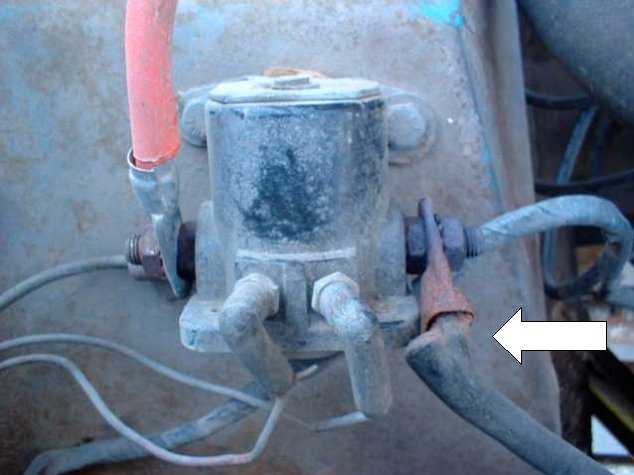|
Problem: Cranks slow.
Test #1 - Make the following checks first:
Fully charged battery
Clean battery terminals
Inspect Pos. and Neg. cables for proper routing and clean tight connections.
I ignored the above suggestions for this article to show the voltage readings of a bad starting system.
Test #2 - Check the battery. Measure the battery voltage before you start. Pos. lead of Voltmeter to Pos. terminal of battery and the Neg. lead of Voltmeter to Neg. terminal of battery. 12.5 volts or better is good, if less then charge the battery first. Attempt to crank the engine and note battery voltage, 9 volts is minimum. Anything less indicates a poorly charged or bad battery.
Test #3 - Check the ground system. This test checks the integrity of the entire ground system from the battery to the engine block. Leave your Neg. Voltmeter lead hooded to the Neg. battery terminal and move the Pos. lead of Voltmeter to a clean ground on the engine. Attempt to crank the engine and note the battery voltage. Any reading above 0.2 volts while cranking is bad. My reading was 1.09 volts.
Test #4 - Check the Pos. side. This test checks the integrity of the entire Pos. side of the starting system between the battery and the starter. Remove your test leads and hook the Pos. Voltmeter lead to the Pos. battery terminal and hook the Neg. Voltmeter lead to the starter motor terminal. (Cable from solenoid to starter.) Attempt to crank the engine and note the Voltmeter readings (ignore Voltmeter reading before cranking). Any reading above 0.3 volts is bad. My reading was 3.48 volts.
Test #5 - Check the starter cable. Remove Pos. Voltmeter lead from battery and hook it to the starter side of the solenoid and note Voltmeter reading while attempting to crank the engine. Any reading above 0.2 volts is bad. My reading was 2.43 volts.
Test #6 - Check the solenoid contacts. Hook your Voltmeter Pos. lead to the battery terminal side of the solenoid and the Voltmeter Neg. lead to the starter terminal of the solenoid (ignore Voltmeter reading before cranking) and note Voltmeter reading while attempting to crank the engine. Any reading above 0.1 volt is bad. My reading was 0.07 volts.
Test #7 - Check the battery cable to starter solenoid. Hook Voltmeter Pos. lead to Pos. battery terminal and voltmeter Neg. lead to battery side of solenoid. Attempt to crank the engine and note Voltmeter readings. Any reading above 0.2 volts is bad. My reading was 1.01 volts.
Interpreting the test results:
- Test #1 will solve many starting problems.
- Test #2 will test the basic integrity of your battery.
- Test #3 Ground system. Result of test indicates a poor ground condition. Visual inspection revealed loose and corroded battery cable to terminal connections. Block connection was good. The proper repair will be a new Negative battery cable. See Fig. 1
- Test #4 Positive side. Result of test indicates poor connections (too much resistance).
- Test #5 Starter cable. Result of this test indicates a poor connection or cable. Visual inspection confirmed a bad cable, melted insulation at terminal connector for solenoid. This cable needs replacing. See Fig. 2
- Test #6 Solenoid contacts. This test indicated good solenoid contacts. No problem here.
- Test #7 Battery cable. This test indicated poor connections. Visual inspection confirmed dirty connection between battery terminal and cable.
Make the needed corrections indicated by the tests above and retest the system to confirm the repairs you made were effective. If it still cranks slowly, the starter motor is bad.
Problem: Engine does not crank, solenoid chatters or doesn't click
1. Complete test #1 and #2 above.
2. Check ignition switch. This is a quick test of the circuit between the battery and the solenoid. Remove the wire going to the solenoid "S" terminal and hook up your headlight test light. One lead to the wire removed from the solenoid the other lead hooked to a known good ground. Attempt to crank the engine and observe the test light. If the light comes "on" at full intensity, this circuit is good. If the light does not come "on" or does not come "on" at full intensity, further testing of this circuit is required. The tests for this system are beyond the scope of this text. Consult your wiring diagram and perform the voltage drop test on the components in your system (key switch, neutral safety switch, and wiring).
3. Check the solenoid ground. This test assumes your ignition switch circuit is good. Use your Voltmeter to perform a voltage drop test to confirm the ground. Hook the Neg. lead of Voltmeter to Neg. terminal of the battery and the Pos. lead of Voltmeter to the ground lug or bolt of the solenoid. Attempt to crank engine and note the volt reading on your Voltmeter. Less than 0.2 volts, good reading, no problem with ground. More than 0.2 volts indicates a poor ground to the solenoid. No reading would indicate a possible open circuit in the solenoid itself. Substitute a known good solenoid or remove the solenoid and test as per your Repair guide. There should be a resistance value in your Repair guide for the "S" terminal to ground. A 0 (zero) ohms reading would indicate a shorted winding and an (infinity reading) would indicate an open winding. Any other reading should be compared against the specs in your Repair guide. If the results of your tests confirm the solenoid is good, verify the ground cable between the battery and engine block to make sure it is good. If the solenoid tests good and the ground cable is good, then the starter motor is bad.

Fig 1 Note corrosion on cable and under terminal. Arrow points to loose bolts.

Fig 2 Arrow points to bad cable. Note insulation has overheated and peeled away. Wire is corroded inside cable terminal end.
|



